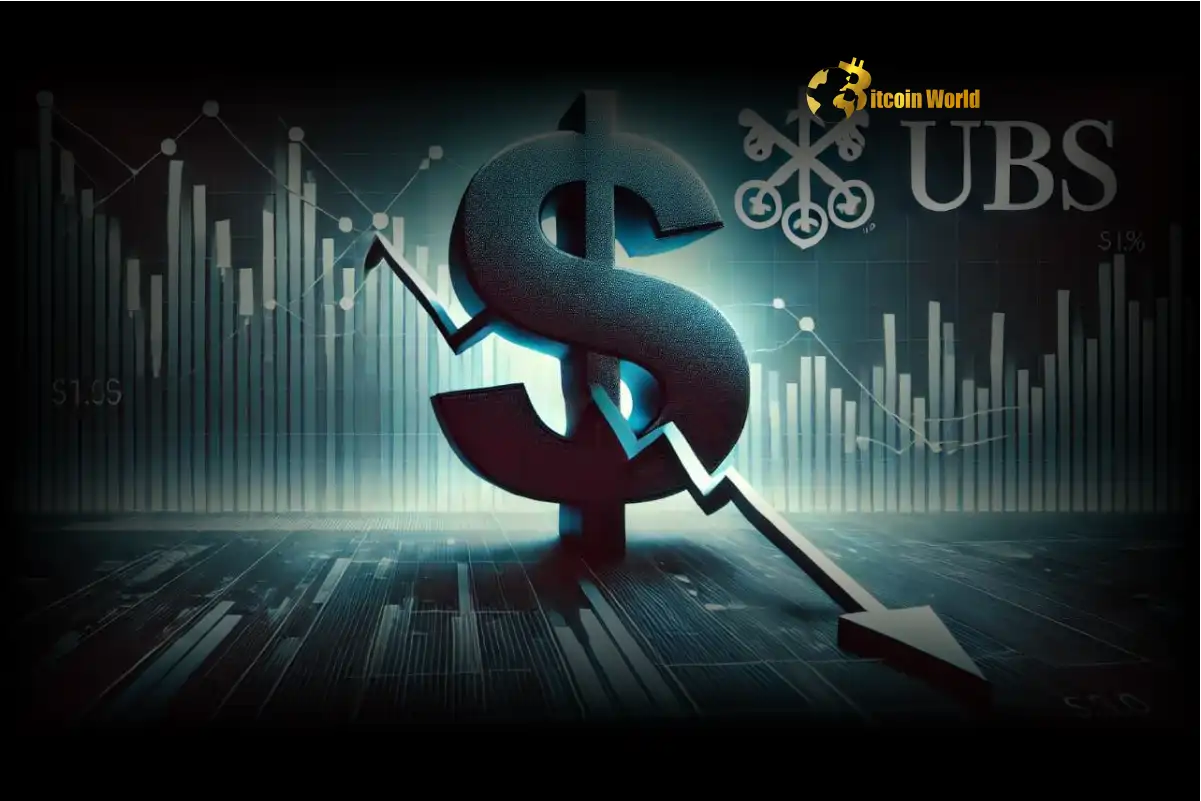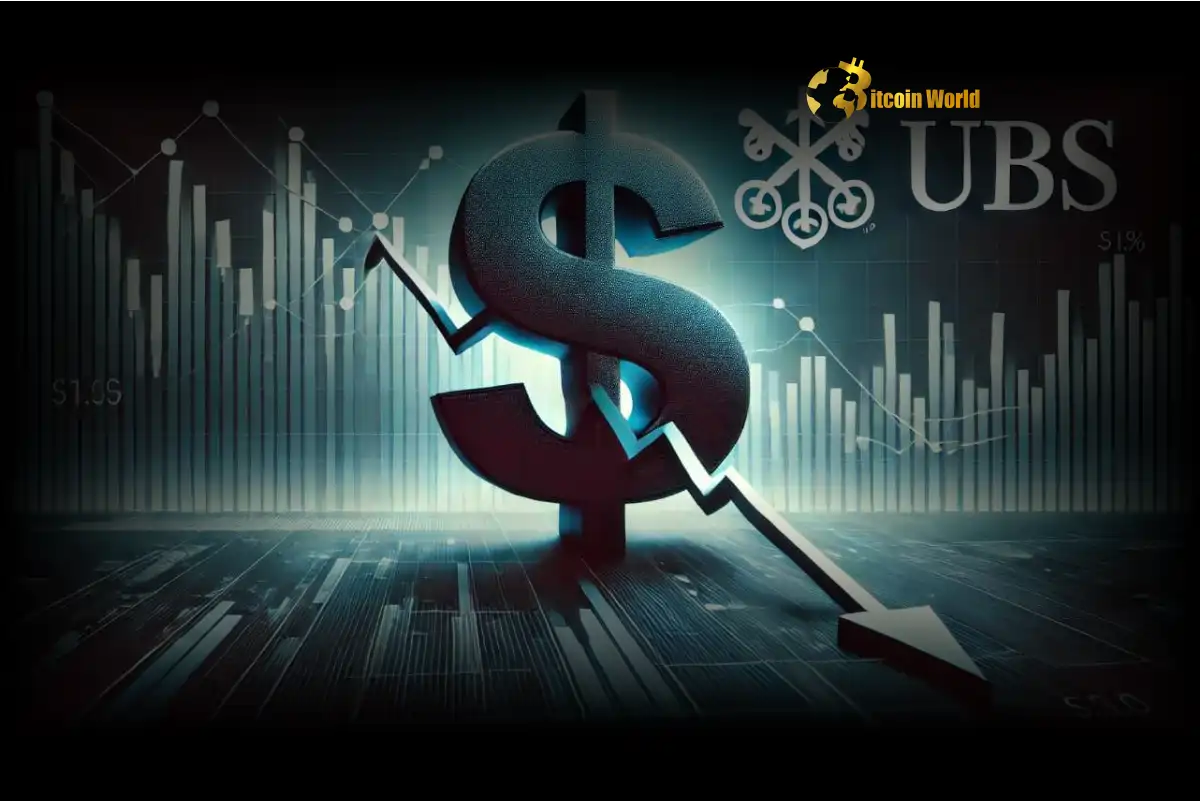BitcoinWorld

Crucial Dollar Weakness: UBS Forecasts Extended Decline to 2026
Are you keeping an eye on global economic shifts? If you’re involved in the cryptocurrency space or broader financial markets, understanding the direction of major currencies like the US Dollar is absolutely crucial. A recent outlook from UBS, a leading global financial services firm, suggests a significant trend is set to continue: persistent US Dollar weakness, potentially lasting all the way into 2026. This isn’t just a minor fluctuation; it’s a forecast that could have ripple effects across various asset classes, including digital currencies.
What is Driving This US Dollar Weakness Forecast from UBS?
UBS’s projection isn’t pulled from thin air. It’s based on an analysis of several key macroeconomic factors and expected policy shifts. The core argument revolves around the idea that the conditions that previously supported a strong dollar are expected to diminish or reverse over the next couple of years. Let’s break down some of the primary drivers cited in their UBS forecast:
- Changing Interest Rate Differentials: For a period, the US Federal Reserve’s aggressive interest rate hikes made the dollar attractive to global investors seeking higher yields. UBS anticipates that as inflation cools and other central banks potentially keep rates higher for longer relative to the Fed’s potential cuts, this yield advantage for the dollar will erode.
- Improved Global Growth Outlook: While the US economy has shown resilience, an expected pickup in growth in other major economies (like the Eurozone or parts of Asia) can draw investment away from dollar-denominated assets and boost demand for other currencies.
- Fiscal Policy and Debt Concerns: The large US fiscal deficit and growing national debt are long-term concerns that can weigh on currency value, especially as alternative investment destinations become more appealing.
- Normalization of Supply Chains and Inflation: As global supply chains heal and inflationary pressures ease globally, the need for the dollar as a safe-haven or for purchasing dollar-denominated commodities might decrease slightly, reducing some sources of demand.
This confluence of factors paints a picture where the structural tailwinds for the dollar are fading, leading UBS to predict a period of sustained depreciation.
Understanding the Broader Forex Market Trends
The Forex market trends are complex, with countless factors influencing exchange rates daily. However, forecasts like the one from UBS highlight significant expected shifts in the underlying dynamics. When we talk about dollar weakness, it’s always relative to other currencies. This means that while the dollar might depreciate, other currencies like the Euro, Japanese Yen, or even emerging market currencies could strengthen against it. This shift impacts global trade, capital flows, and investment decisions.
Historically, major currency cycles can last for several years. The period leading up to recent times saw significant dollar strength driven by unique economic conditions. UBS’s forecast suggests we are entering a new phase, potentially a multi-year cycle of dollar decline. This has implications not just for international businesses and travelers but for investors holding assets denominated in or influenced by the dollar.
Consider the following points regarding the impact of shifting Forex market trends:
- Export Competitiveness: A weaker dollar makes US exports cheaper for buyers using other currencies, potentially boosting American businesses.
- Import Costs: Conversely, imports become more expensive for US consumers and businesses.
- Corporate Earnings: US companies with significant international operations might see their foreign earnings translate into more dollars when the dollar is weak.
- Commodity Prices: Many major commodities (like oil and gold) are priced in dollars. A weaker dollar can make these commodities cheaper for holders of other currencies, potentially increasing demand and price.
How Does This Macroeconomic Outlook Influence Global Markets?
A significant change in the value of the world’s primary reserve currency has widespread effects. The Macroeconomic outlook painted by UBS’s dollar forecast suggests potential shifts in global capital allocation. Investors might look to diversify away from dollar-heavy portfolios. This could mean increased investment interest in:
- International Equities: Stock markets in countries whose currencies are expected to strengthen against the dollar could become more attractive.
- Commodities: As mentioned, a weaker dollar can be bullish for dollar-denominated commodities like gold, silver, and oil.
- Emerging Markets: These markets often benefit from a weaker dollar, as it eases the burden of dollar-denominated debt and can attract capital flows.
Furthermore, central banks globally hold vast reserves primarily in US Dollars. A forecast of sustained dollar weakness might prompt some central banks to subtly diversify their reserves over time, although any major shift would be gradual and carefully managed to avoid market disruption.
The interplay between currency movements, interest rates, inflation, and growth forms the core of the Macroeconomic outlook. A forecast like this provides a potential roadmap for how these elements might interact over the medium term, guiding investment strategies and risk assessments for institutions and individuals alike.
What Does the Crypto Market Outlook Look Like Amidst Dollar Weakness?
Now, let’s bring it back to the digital asset space. How does a forecast of persistent US Dollar weakness potentially impact the Crypto market outlook? While the relationship isn’t always direct or perfectly correlated, there are several theoretical and observed connections:
- Inverse Correlation Tendency: Cryptocurrencies, particularly Bitcoin, are sometimes viewed as alternative assets or stores of value outside the traditional financial system. When the value of traditional fiat currencies like the dollar declines, assets perceived as alternatives, including crypto and gold, can become more attractive. This can lead to an inverse relationship where dollar weakness coincides with rising crypto prices.
- Increased Liquidity and Risk Appetite: Conditions that lead to dollar weakness (like lower US interest rates relative to others, or increased global liquidity) can sometimes fuel greater risk appetite among investors. Cryptocurrencies, being higher-risk assets, can benefit from this environment as investors seek potentially higher returns outside of traditional safe havens.
- Capital Flows: If global investors are moving capital out of dollar-denominated assets, some of that capital could potentially flow into the crypto market, especially as institutional adoption grows.
- Stablecoin Dynamics: A significant portion of the crypto market’s liquidity is held in dollar-pegged stablecoins. While their value is tied to the dollar, the overall sentiment around the dollar’s strength can still influence trading behavior and flows between stablecoins and volatile cryptocurrencies.
It’s important to note that the crypto market is also influenced by its own unique factors, such as technological developments, regulatory news, and market sentiment specific to digital assets. However, the macroeconomic backdrop, including the trajectory of the US Dollar, provides a significant layer of influence on the overall Crypto market outlook.
Navigating the Environment: Actionable Insights
Given the UBS forecast for sustained Dollar weakness forecast, what steps might investors consider? Remember, this is not financial advice, but rather points to ponder based on the potential implications:
- Diversification: Consider diversifying portfolios beyond heavily dollar-denominated assets. This could involve exploring international stocks, commodities, or alternative assets like cryptocurrencies.
- Evaluate Currency Exposure: Understand your existing exposure to the US Dollar, both direct (cash, US stocks) and indirect (companies with significant US operations).
- Consider Gold and Commodities: Historically, gold performs well during periods of dollar weakness. Other commodities priced in dollars may also see upward price pressure.
- Assess Cryptocurrency Holdings: If you believe the inverse correlation tendency holds, a period of sustained dollar weakness could be a favorable environment for cryptocurrencies. However, always conduct thorough research into specific crypto projects.
- Stay Informed: The macroeconomic landscape is constantly evolving. Keep track of updates from central banks, economic data releases, and revised forecasts from institutions like UBS.
Understanding the potential for sustained Dollar weakness forecast allows investors to proactively assess their strategies rather than reacting after the fact. It’s about positioning your portfolio for a potentially different global economic environment than the one we’ve seen in recent years.
Potential Challenges and Counterarguments
While UBS presents a compelling case, it’s crucial to acknowledge that economic forecasting is not an exact science. Several factors could challenge or alter the forecast for sustained US Dollar weakness:
- Unexpected US Economic Strength: If the US economy continues to outperform other major economies significantly, it could attract capital and support the dollar.
- Global Shocks: Unforeseen geopolitical events or global economic crises could increase demand for the dollar as a traditional safe-haven currency, reversing the weakness trend.
- Policy Errors or Shifts: Unexpected changes in monetary or fiscal policy in the US or other major economies could alter currency trajectories.
- Inflation Persistence: If inflation proves more stubborn globally, central banks might keep rates higher for longer, which could change relative interest rate differentials in unpredictable ways.
Therefore, while the UBS Forex forecast provides a strong base case, investors should remain agile and monitor economic developments closely. The path of the dollar will likely be volatile, even within a broader trend of weakness.
Summary: Preparing for a Weaker Dollar Environment
UBS’s forecast for continued US Dollar weakness until 2026 signals a potential multi-year shift in global currency dynamics. Driven by factors like changing interest rate differentials, improving global growth, and fiscal considerations, this UBS forecast suggests the macroeconomic environment is evolving. These expected Macroeconomic trends have significant implications for global markets, potentially favoring international assets, commodities, and influencing the Crypto market outlook.
While challenges and uncertainties exist, understanding this potential trend allows investors to consider strategic adjustments to their portfolios. Whether through diversification, re-evaluating currency exposure, or considering assets like gold and cryptocurrencies, preparing for a weaker dollar environment is a prudent step for navigating the financial landscape over the coming years. Staying informed about these major Forex market trends is key to making informed investment decisions in an interconnected global economy.
To learn more about the latest Forex market trends, explore our article on key developments shaping the US Dollar and macroeconomic outlook.
This post Crucial Dollar Weakness: UBS Forecasts Extended Decline to 2026 first appeared on BitcoinWorld and is written by Editorial Team





